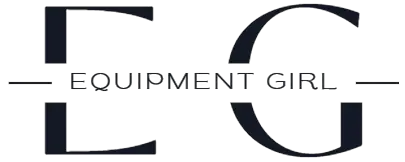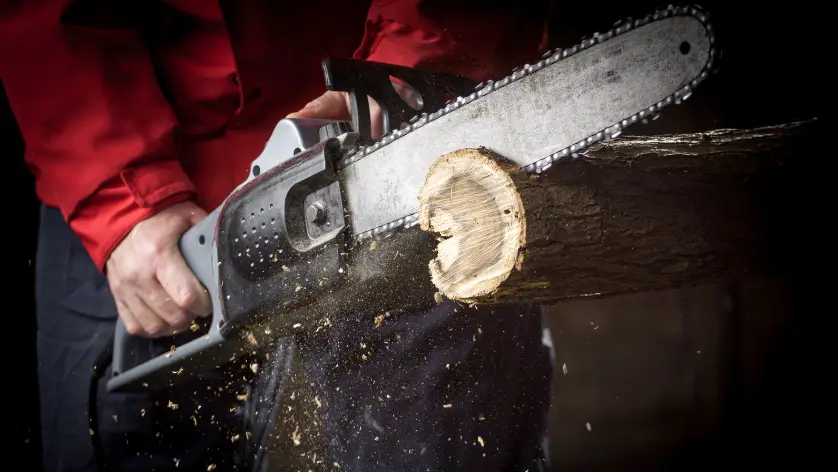One of the most important things to get right as a chainsaw owner is the chainsaw blade direction. Put the chainsaw chain on wrong, and you’ll be left with a chainsaw that doesn’t cut, and a red face.
There are a few things you can do to make sure the chainsaw chain is in the right direction, and today’s post will focus on explaining chainsaw blade direction to you, the problems of putting the chain in the wrong direction, and how to correct any issues you have so you can use your chainsaw properly.
Sounds good? Then let’s get on with it!
The Importance Of A Chainsaw Chain Direction
Why does your chainsaw chain direction matter? Well, simply because if your chainsaw chain direction is wrong, your chainsaw will be ineffective and potentially dangerous to you.
A chain in the wrong direction actually means that the chainsaw’s cutting teeth will be facing towards you (meaning all the cutters are facing you), and although the chainsaw body is what you’ll be holding, attempting to cut with the cutting edges in the wrong way could lead to a serious accident that damages your chainsaw and potentially injures you.
Getting your chainsaw blade direction correct is important. The correct direction means your saw chain will do as it should, cutting wood easily, and keeping you safe whilst doing it.
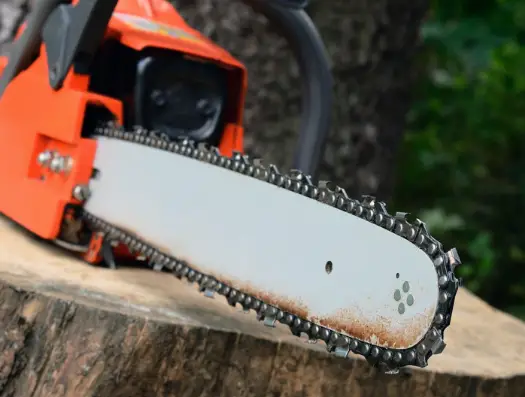
Which Way Does A New Chain Go On A Chainsaw?
A chainsaw blade’s direction is vital. The cutters hitting wood is what makes a saw chain effective, so a correctly mounted chain will always show the cutting teeth so when you start it, the teeth will run against the wood and chop it up as planned.
The cutting blade needs to run in a clockwise direction in order to cut in only one direction to be effective. So you should always ensure your chainsaw chains run clockwise to avoid a backward direction which could cause problems.
What Happens When You Put Your Chainsaw Chain On Wrong?
Put the blade on in the incorrect direction, and your chain will run backwards. A backwards chain chainsaw direction can lead to five key problems:
1. Embarrassing…
Yes, that’s right. If you don’t know how a chain is supposed to go on a chainsaw, you run the risk of not doing it in the correct direction.
Away from all the other problems you’ll face, it just won’t cut, leaving your face red.
A chainsaw dealer or professional knows how to mount their new chainsaw chain correctly every time, but it’s not so easy for the rest of us who aren’t familiar with chainsaw direction.
It’s OK to get it wrong and realise your mistake quickly. But if you don’t realise the issue right away, you might be left with problems with your chainsaw blades and chainsaw more generally, causing issues that may be irreparable…
2. Chain Links Damaged
Your chain links becoming damaged is a very real possibility if you get your chainsaw chain direction wrong. In order for your chainsaw to, well, chainsaw effectively, the chain link needs to be moving in the right direction, or else the heavy duty chain will be placed under a huge amount of unnecessary pressure and wear by the rotating backward chain.
Ensure the drive links (a drive link is simply what drives the blade direction and allows the cutting blades to rotate and cut into wood) are on correctly and rotating clockwise. Otherwise, it may become burned out quickly, and your chain link will need to be replaced.
Note: Replacing your drive links isn’t easy, because you’ll need to know the right drive link count for your chainsaw, etc., and very few people have this information to hand. That’s why it’s best to ensure the chain direction is right before you run the chainsaw, because a burned out chain link is a problem you don’t want to deal with.
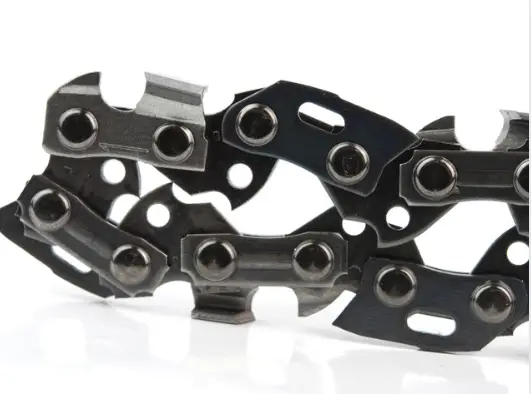
3. Clutch Burnout And Motor Deterioration
When you place your chain in the wrong way on your chainsaw, the blunt edge of your chain will be hitting the wood. As the chain rides around, the blunt side of the blade will be constantly hitting the wood, whilst making very little progress.
Not only is the slow progress irritating, it’s terrible for the clutch and the motor.
The amount of resistance your chainsaw will be dealing with increases exponentially when the actual cutting isn’t taking place because the sharp edge isn’t where it ought to be. This extra resistance forces the clutch and motor to work much harder until eventually it can burn out altogether.
This will reduce power. And since a chainsaw is a power tool, a lack of power makes it a pretty poor power tool, right?
4. Waste Bar Oil/Damage Because Of Overheating And Poor Lubrication
You’ll need to use good bar oil to keep the sharp edges well lubricated and prevent it from becoming a dull chain or a broken chain too easily. However, when you use bar oil to lubricate a chainsaw blade that’s moving in the wrong direction, all you’re doing is wasting good oil.
Even worse for your chainsaw, a lack of lubrication means that, as the chainsaw chain moves in the wrong way, it will encounter more friction. This friction can easily lead to overheating and the need for you to find an exact replacement chain.
Note: Finding the correct replacement chain is also difficult. Getting the right gauge, pitch, and drive link count is essential, and unless you have a fancy digital calliper to help you find that information, it’s not easy to know. So it’s best to avoid needing a new chainsaw chain altogether by ensuring the chainsaw chain is moving in the right direction and is well lubricated.
5. Guide Bar Problems
Your chainsaw guide bar is one of the most important parts of your chainsaw. It’s the reason the chainsaw’s sharp edges are able to move in the same direction and cut through wood like a hot knife through butter.
However, your chainsaw chain direction is so important to get right, or else the chainsaw bar will be placed under too much stress.
When moving in the wrong direction, the guide bar will be forced to work overtime, because the teeth of the saw aren’t doing the work – the user’s muscles alone are. That forces a lot of pressure on the guide bar which would usually move through the wood with the blade easily because the teeth do most of the work.
Because a regular chainsaw user might not notice that the teeth aren’t doing the work, they’ll continue to apply more pressure, until eventually the guide bar is overstressed, becomes worn, or even breaks altogether. A situation you want to avoid at all costs.
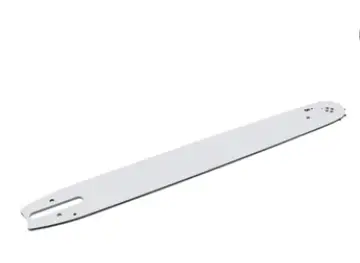
Checking The Chainsaw Blade Direction Is Correct
Now you know what the chainsaw chain direction can mean for your chainsaw when the blade rotates in the wrong direction, let’s focus on how to make sure it’s running in the right direction.
Check From Above
Remember, every chainsaw blade runs in a clockwise direction. That’s the right way for the chainsaw blade to go on a chainsaw. In order to make sure that’s happening, you can inspect your chainsaw from different angles – starting first, from above.
As you look down on your chainsaw from above, you’ll see several blades with two edges: one sharp, one dull. Regardless of model, or size (it doesn’t matter if the chainsaw is a smaller one or a heavier and bigger saw with a heavier duty chain), all chainsaws run clockwise. That means the sharp edge of the blade must also run in the same direction.
Start your chainsaw and look from above. If the sharp teeth are moving clockwise, and are facing the direction opposite the chainsaw body or motor, then its mounting direction is correct. If not, it’ll need to be adjusted.
Check From The Side
You can confirm that the blade direction is correct if you look from the side, with the chain on your right and chainsaw body on the left side. As it runs, the blade should be moving from left to right in a rotating motion for it to be running in the right direction.
Check From The Front
Likewise, you can check the chainsaw direction from the front. If the chain direction is moving from the upside to the downside, then it’s mounted correctly and is heading clockwise. If it is going the other way, then it’s mounted incorrectly.
Check From Below
From below, the blades should face the engine of the chainsaw – essentially, it should appear opposite to the view from above.
Note: Even chainsaw users who have operated chainsaws for years will still complete these checks before cutting wood after replacing a chain. That way, they won’t accidentally stress the chainsaw engine or components, so it’s a good habit to get into with your chainsaw at home.
Fixing A Chainsaw Blade In The Wrong Direction
If, after the simple checks above, you’ve determined that the blade direction is wrong, then here’s how to fix it.
Attach Chainsaw Bar And Chain Loosely
The first thing you’ll need to do after taking the chain off is put it in the opposite way to how you had it before. This will, obviously, mean it’s facing the right direction this time.
Your bar and chain is the first thing to get right.
Remove the chain bar by loosening the bar nuts at the top of the bar so the chain bar can be moved.
Install the chain bar carefully to face the right direction this time, and then put the chain on loosely. You don’t want a lot of chain tension yet, because you still need to ensure the blade is attached correctly, too.
You can tighten the bar nuts lightly here, to ensure nothing moves as you check the blade direction is right.
Check Chainsaw Blade Direction
Simply use the checks discussed above to ensure the chainsaw blade direction is correct now.
Tighten The Chainsaw Chain
Finally, simply tighten the chainsaw chain into position once you’re sure the blade direction is correct this time. Try not to tighten too much, or too little. A loose or over tightened chain will wear down much quicker than one that’s perfectly in place.
After everything is tightened, you can practise on a thinner piece of wood to ensure the blade is cutting correctly and moving in the right direction.
Once you’re happy everything is running as it should, you can use your chainsaw as normal.
A Note On Safety
We shouldn’t need to say this, but your safety is vital. When touching the chain, the chainsaw should be off, obviously, but you should also be wearing protective gear like goggles, gloves, and overalls that won’t allow the blade’s teeth to cut you accidentally.
When viewing the chainsaw chain’s direction in operation, you should always stand in a sensible position to ensure no accidents occur.
Anybody who uses a chainsaw knows that safety is important, but just use common sense when checking the chain direction too. You don’t want to cause yourself or someone else an injury.
Final Message
As you can see, you won’t need specialised tools or complicated gadgets to change your chain direction if it’s wrong, but you will need to see to it quickly to avoid the issues we discussed above.
It’s always a good idea to check that the blade is rotating in the right direction before cutting any wood whenever you replace the chain, and if you notice any issues like chainsaw shakes or noisy/overworked parts, then stop immediately and double check the chain direction.
It’s dangerous and costly to run a chain in the wrong direction, so check it whenever you’ve removed the chain to avoid issues.
Hopefully, today’s post has shown how easy it is to check a chainsaw chain direction, though, and how easy it is to set it right if you notice any problems!
